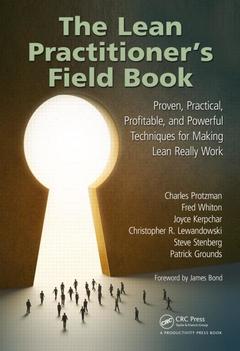Description
The Lean Practitioner's Field Book
Proven, Practical, Profitable and Powerful Techniques for Making Lean Really Work
Authors: Protzman Charles, Whiton Fred, Kerpchar Joyce, Lewandowski Christopher, Stenberg Steve, Grounds Patrick
Language: English
Subjects for The Lean Practitioner's Field Book:
Keywords
Big Archive; Lean Overview; Lean Philosophy; History; Principles; and Change Management; Cycle Time; Phase I: Lean Tools and Implementation; MBA School; Leveraging the Lean Business Delivery System for Continuous Improvement; Point Kaizen Event; Lean Implementation Phase II through IV; Basic Model; Lean Customer Relationship Management; Heijunka Box; Fred Whiton; Single Piece Flow; Joyce Kerpchar; Standard Work Combination Sheet; Christopher R; Lewandowski; Changeover Analysis; Steve Stenberg; Takt Time; Patrick Grounds; Standard WIP; James Bond; Lean Initiative; profitable company; QDIP; lean techniques; Leader Standard Work; lean practitioner; Gemba Walk; return on investment; Work Order; Lean Implementation; Lean Journey; Kaizen Event; Water Spiders; Hoshin Plan; Material Requirement Planning System; Ceo Level; Lean Project; Group Tech Matrix
Approximative price 103.03 €
In Print (Delivery period: 15 days).
Add to cart· 17.8x25.4 cm · Hardback
Description
/li>Contents
/li>Readership
/li>Biography
/li>
While there are numerous Lean Certification programs, most companies have their own certification paths whereby they bestow expert status upon employees after they have participated in or led a certain number of kaizen events. Arguing that the number of kaizen events should not determine a person's expert status, The Lean Practitioner's Field Book: Proven, Practical, Profitable and Powerful Techniques for Making Lean Really Work outlines a true learning path for anyone seeking to understand essential Lean principles.
The book includes a plethora of examples drawn from the personal experiences of its many well-respected and award-winning contributors. These experts break down Lean concepts to their simplest terms to make everything as clear as possible for Lean practitioners. A refresher for some at times, the text provides thought-provoking questions with examples that will stimulate learning opportunities.
Introducing the Lean Practitioner concept, the book details the five distinct Lean Practitioner levels and includes quizzes and criteria for each level. It highlights the differences between the kaizen event approach and the Lean system level approach as well as the difference between station balancing and baton zone.
This book takes readers on a journey that begins with an overview of Lean principles and culminates with readers developing professionally through the practice of self-reliance. Providing you with the tools to implement Lean tools in your organization, the book includes discussions and examples that demonstrate how to transition from traditional accounting methods to a Lean accounting system.
The book outlines an integrated, structured approach identified by the acronym BASICS (baseline, analyze, suggest solutions, implement, check, and sustain), which is combined with a proven business strategy to help ensure a successful and sustainable transformation of your organization.
Lean Overview, Lean Philosophy, History, Principles, and Change Management. Phase I: Lean Tools and Implementation. Lean Implementation Phase II through IV. Appendices.
Charles Protzmanformed Business Improvement Group (B.I.G.), LLC, in November 1997. B.I.G. is located in Baltimore, Maryland, and specializes in implementing Lean thinking principles and the Lean business delivery system—LBDS (trademark pending).
Charles has over 31 years of experience in materials and operations management. He spent 13 years with AlliedSignal, now Honeywell, where he was an aerospace strategic operations manager and the first AlliedSignal Lean master. He has received numerous special-recognition and cost-reduction awards. Charles was an external consultant for DBED’s Maryland Consortium while he was with AlliedSignal. He had input into the resulting world class criteria document and assisted in the first three initial DBED world class company assessments. He is an international Lean consultant and has taught students courses in Lean principles and total quality worldwide.
Charles spent the last 18 years implementing successful Lean product line conversions, kaizen events, and administrative business system improvements (transactional Lean) across the United States. He is following in the footsteps of his grandfather, who was part of the Civil Communications Section (CCS) of the American Occupation. Prior to Deming’s 1950 visit to Japan, C.W. Protzman Sr. surveyed over 70 Japanese companies in 1948. Starting in late 1948, Homer Sarasohn and C.W. Protzman Sr. taught top executives of prominent Japanese companies an eight-week course in American participative management and quality techniques in Osaka and Tokyo. Over 5100 top Japanese executives had taken the course by 1956. Many of the lessons we taught the Japanese in 1948 are now being taught to Americans as "Lean principles." The Lean principles had their roots in the United States and date back to the early 1700s and later to Taylor, Gilbreth, and Henry Ford. The principles were refined and expanded by Shigeo Shingo and Taiichi Ohno at Toyota. M




